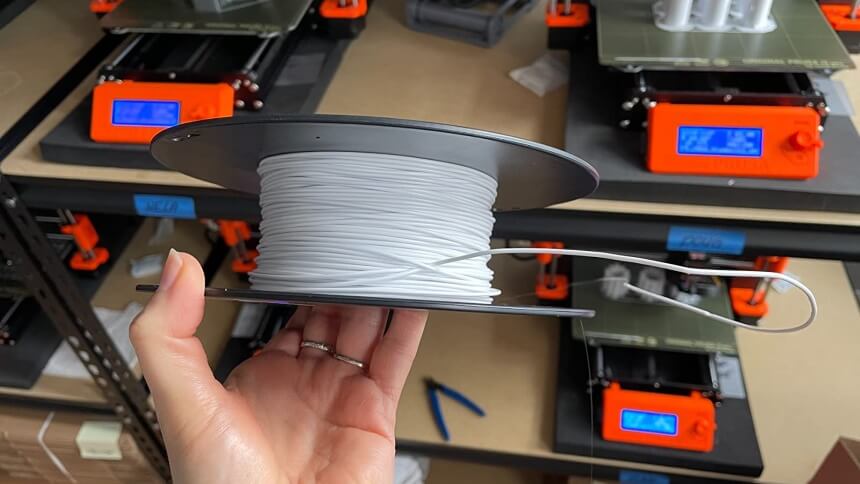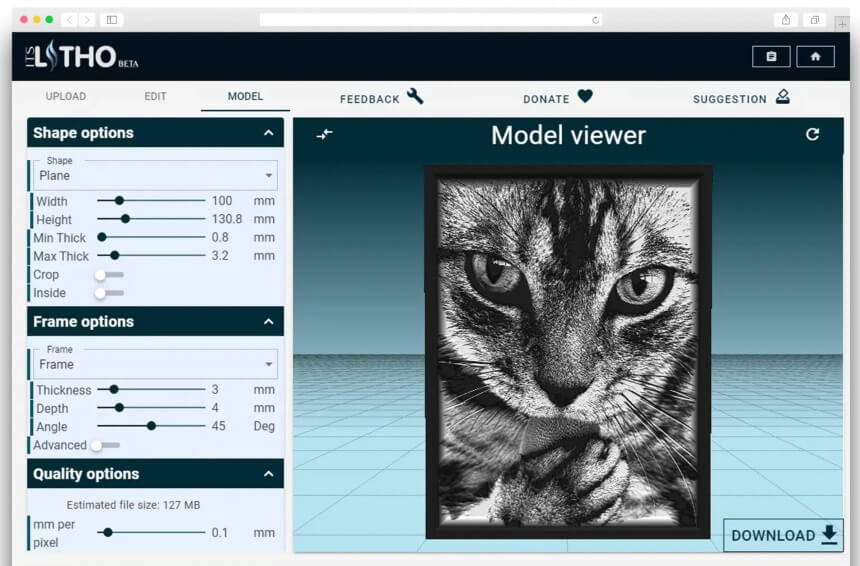

A lithophane is a beautiful piece of art once carved out of porcelain. Today we have the advantage of creating impressive lithophanes using a 3D printer. These unusual art pieces have a hidden secret that can only be revealed when light shines behind them. We have put together this helpful guide to make sure you use the best filament for lithophanes with all your creations.
We’ve looked at 22 different options picking the 5 best ones, out of which, the Ivory White PLA Filament is our Editor’s Choice. Lithophanes are printed on thin material with varying thicknesses. The thicker areas of the lithophane block more light than the thinner areas, allowing the user to create customized designs on the material that are revealed with light. The outcome of your 3D lithophane is reliant on the type of filament used with your printer. Using the right type of filament will ensure that you get the best possible results.
Here we will take a closer look at the different types of filament available, which works best for creating lithophanes, and what you should know to help you choose the best filament for your project.
The Ivory White PLA Filament from FilaCube is great for printing bone, figurines, pearl jewelry, necklaces, and lithophanes. It is the ideal product when you want to create 3D prints with excellent detail and smooth surfaces. This filament is softer and more flexible than traditional PLA Ivory filament. And since it has such a smooth texture, it can save the user time on sanding or primer processes.
This FilaCube filament is an excellent product to use when you want to make prints with professional results. It is highly recommended for those who create lithophanes because it can create an antique look with little effort. The spools are well wound, and many customers claim that using this filament is much easier and less of a hassle than other brands.
This AMOLEN Glow-in-the-Dark PLA Filament changes color every 5 meters to give you a unique and visually stunning print. It only needs to be exposed to direct sunlight or UV light for 30 minutes to provide you with an intense glowing effect. Add vibrant, glowing colors Green, Blue, Pink, and Purple to your customized prints and lithophanes for an extra special touch.
This filament was designed with creativity in mind. The possibilities for what you can create with this color-changing filament are endless. The AMOLEN brand specializes in creating Glow-in-the-Dark filament using some of the best materials in the industry.
The eSUN PLA PRO Filament is our choice for most eco-friendly. This filament has a low shrinkage rate and will stick easily to the printer bed and other layers. It is designed to be strong with better toughness and is compatible with most FDM 3D printers. This filament is available in a variety of colors, so you can create many different types of prints.
This eSUN filament is a great option for those new to 3D printing because it is extremely durable and will not cause users much of a problem with breakage or shrinking.
The OVERTURE PLA filament is our choice for the best value. A spool of this filament costs around $20. It is designed with a bubble-free patent that ensures you will enjoy a smooth printing experience. With less tangling and less chances of line breaking, this is the ideal filament to use for everyday projects.
OVERTURE filament can be used to create all types of items, from vases to prototypes and pencil holders. It is compatible for use with most 3D printers and is made from biological material that has been extracted from corn grain, making it a sustainable product that is harmless to the environment.
TIANSE Super PLA 3D Printer Filament is our choice for the most durable. This premium, tangle-free filament reduces the chances of failed prints and therefore means less waste for the environment. It provides smooth printing with tight tolerance to make sure your 3D printer always runs hassle-free and provides you with optimal results.
This filament is very smooth and brilliant white however you can purchase it in other colors as well. It is a great choice for beginners because it doesn’t tangle and will not create any obstacles while you are attempting to learn the basics of 3D printing.
As we can see from our product reviews above, there are many different filament types for 3D printers. Whether you are new to 3D printing or you are new to creating lithophanes, choosing the right filament for the job can be tricky. That is why we put together this useful buying guide to help you determine what features to look for and which filament is the right choice for you.
The first lithophanes were made all throughout Europe in France, Prussia, Germany, and England during the latter part of the 1820s. There are several people who were credited with the invention of the lithophane, but most people give credit to Baron Paul de Bourgoing, who invented the process of pottery decorating known as email ombrant. Later, the lithophane process was perfected in 1828 by Georg Friedrich Christoph of Prussia. Still, others will say the process was first developed in Berlin or other parts of Germany by those in the Berlin porcelain industry. For that reason, lithophanes are often referred to as Berlin transparency.
A lithophane can be a treasured item that you can use to display your favorite family photos any way you like. It can also make a wonderful gift for Christmas, Weddings, or Anniversaries. These enchanting creations have been in existence long before the 3D printer was invented, through a long and tedious process that involved carving warm wax on a glass plate. Today, thanks to advancements in technology, we can all learn to create our own stunning lithophanes at home.
A 3D printing project that is this special would require just the right settings and the best materials to ensure everything turns out perfectly. You don’t want to commit a lot of time and energy working on a project only to have it turn out bad because you used the wrong type of filament. Taking the time to learn more about how to choose the best type of filament for your lithophane projects will give you the knowledge and expertise needed to create stunning works of art using your most memorable photos.
Choosing the right filament to make a lithophane requires you to find a filament that is smooth and doesn’t show a lot of layer lines. To accomplish this, you will need high-quality products made from durable materials that can withstand all the steps of the lithophane process.
Several important features can make your lithophane project either a failure or a success.

Filament is made from various materials, including polylactic acid (PLA), Acrylonitrile butadiene styrene (ABS), Polyethylene terephthalate (PET), Polycarbonate (PC), Thermoplastic elastomers (TPE), and Nylon. Different projects require different types of filament material. For lithophanes, PLA filament works best. PLA can be a very easy and smooth filament to work with, ensuring you get a good outcome with your project. When choosing a PLA filament to make a lithophane, keep in mind that light colors work best.
Our eco-friendly choice, eSUN PLA PRO+, is made from biological material extracted from corn grain, making it the ideal green filament for environmentally concise users.
It is best to choose a filament that is 3mm in diameter when creating a lithophane. 3mm filament is a good size, and you can use a raft when you are printing your lithophane that will keep the corners protected and prevent them from warping. Doing so will also ensure that you have more stability while printing. All the products in our review are 1.75 mm, which is also a good choice for creating lithophanes.
In general, PLA filament settings will have an optimal printing temperature range from 185C up to around 205C. Therefore to create a lithophane, you will need to find a PLA filament that has a printing temperature within this range. Our Premium Pick AMOLEN Glow-in-the-Dark PLA Filament has a printing temperature of 190-220˚C, making it a good option for printing lithophanes.
When creating a lithophane, you will want a slower speed than you would normally use on your other 3D printing projects. However, it should not be so slow that it would create problems with your lithophane. It is best to maintain a printer speed of 40 to 60 mm per second. TIANSE Super PLA Filament, our choice for the most durable filament, has a 30 to 90 mm per second printing speed.
When you have the correct dimensional accuracy, it means you will not have any issues with filament going under the extrusion. The best PLA filament to use for lithophanes will have a dimensional accuracy of 0.05mm. Our choice for Best Value, OVERTURE PLA Filament, has a dimensional accuracy of 0.05mm.
Lithophanes can be difficult to create because there are many things you must take into account. You have to get the print settings precisely correct, and the filament that you use will play a major role in that. PLA offers a high flexibility strength and better elongation overall before it breaks. It will also print with a semi-transparent finish, which is good if you want a glossy finish.
After printing, items made using PLA filament can be sanded if needed, however, if that is done, you will need to take greater care of the lithophane. Overall, PLA is the perfect choice when you have a printing project where aesthetics is important. And when it comes to lithophanes, aesthetics are the most important factor of all.

There are several options for 3D printer software that can be used to create lithophanes. Here are a couple of our favorites for you to consider.
Lithophane Maker Trusted Source Image to Lithophane Generator Image to lithophane converter. Free lithophane software that can create lithophane boxes, lamps, night lights, ceiling fans, and more! 3D print lithophanes with the best lithophane software. lithophanemaker.com software transforms your photos into 3D models of lithophanes that can be printed. This easy-to-use software makes it possible to create a number of designs, from night lights to lamp and heart-shaped prints. All you have to do is use the tools to crop your photos and then view your lithophane. Adjust the dimensions and render the resolution to make your lithophane look exactly how you want it. This software makes it possible to place your favorite images on useable items so you can create personalized gifts your friends and family will love.
3DP Rocks Trusted Source 3D Printing Rocks! Free 3D Printing software tool. 3dp.rocks are free 3D printing and design software that is open-source, allowing users to see how it’s done and do it all on their own. It is a great place to start if you are new to 3D printing or new to making lithophanes. When you visit the website, you will have access to free tools such as the image to lithophane converter that conveniently converts any uploaded image into a flat, inner curve, outer curve, solid cylinder, dome, rectangle, or heart-shaped lithophane for you to print. A ring maker tool also allows you to customize jewelry to be printed out enjoyed.
For thickness settings, you should start with a maximum size of 150 mm and a thickness of 3 mm with 0 sets for the border. Using the thinnest layer settings makes it possible to choose the smaller width of your image.
Even after comparing these five excellent products, it can be difficult to choose the best filament for creating lithophanes. They all have something unique to offer that can take your 3D printing to the next level. From filaments made with the highest quality materials to those that create stunning glow-in-the-dark creations, we feel that all of the products we mentioned would be a good fit for any lithophane project. However, we know that our readers are here to find out what we believe is the very best of the best.
Our choice for the best filament for lithophanes would have to be our editor’s choice, the FilaCube Ivory White PLA Filament. It meets all the requirements for creating an excellent lithophane and has received many excellent reviews from satisfied customers.